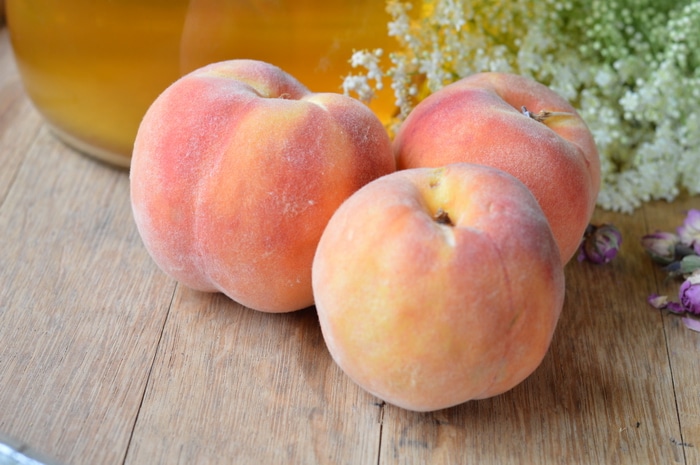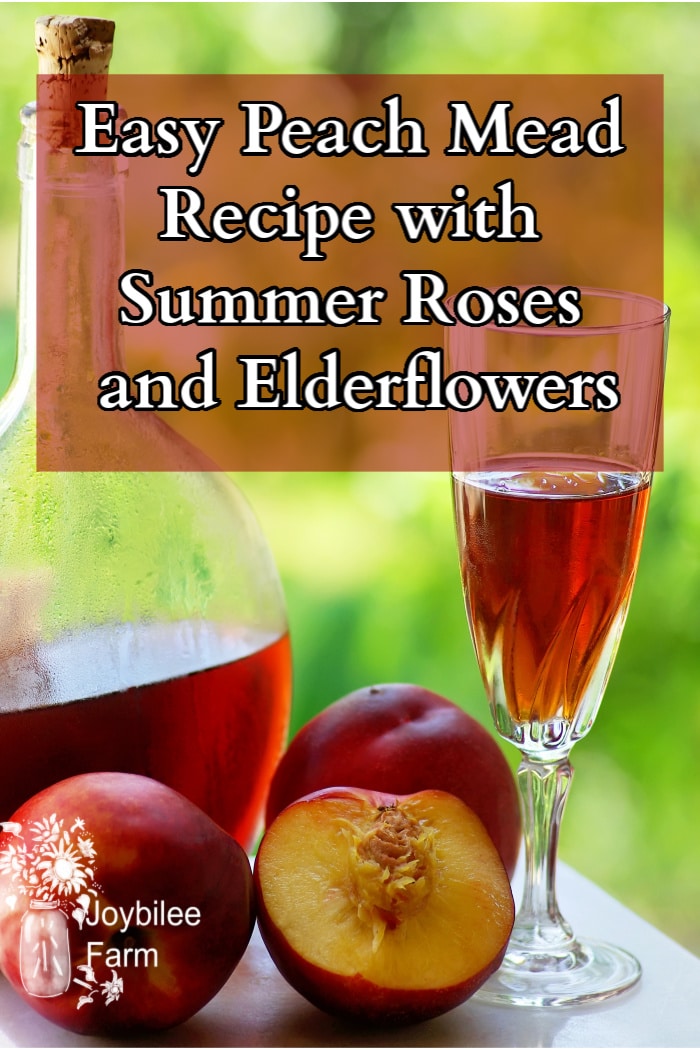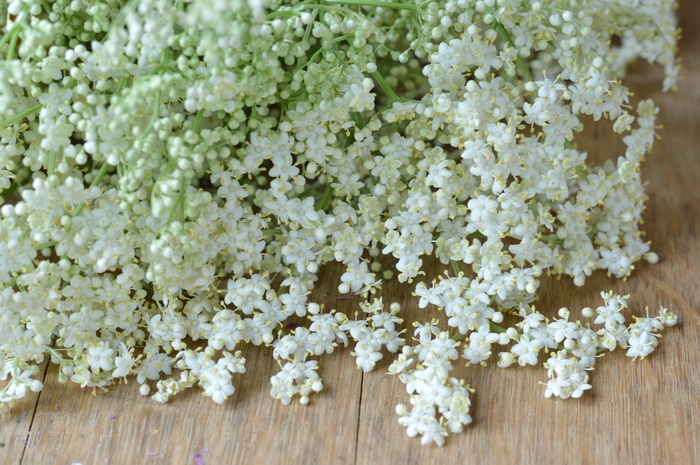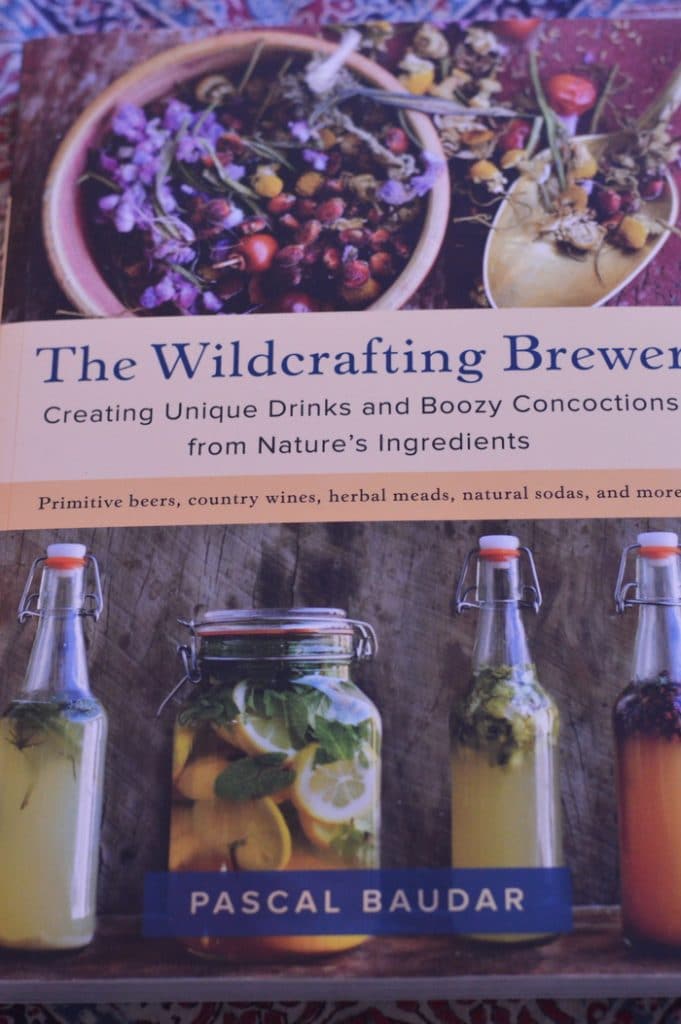This peach mead recipe is easy to make in small batches as the peaches ripen or the roses bloom. Mead is the ideal vehicle for saving summer’s bounty for winter in small batches. Mead is wine sweetened with honey instead of sugar. While you could make mead with only honey and yeast, adding fruit, berries, and herbs to mead recipes offers exciting and limitless possibilities. Chokecherry, dandelion, mint, rosebuds, elderflowers, and elderberries are transformed when fermented in a gallon jug with honey. Plus when you use medicinal herbs in a mead recipe the medicine is preserved along with the flavor.
For this mead recipe, you’ll need fresh, ripe peaches, honey, elderflowers, and rosebuds. Orange juice or grape juice are added to feed the yeast.
Print
Peach Mead Recipe with Summer Roses
- Prep Time: 6 to 8 weeks
- Cook Time: N/A
- Total Time: 0 hours
- Yield: 4 - 24 ounce bottles 1x
- Category: Mead
- Method: Fermentation
Description
The flavor of this mead recipe is delicate and sweet like summer blossoms and fruit.
Ingredients
- 2 quarts of water
- ½ quarts (1.9 L) water
- 2 Tablespoons (30 ml) Elderflowers, stem removed (1/5 ounce, or 5.5 g)
- 3 Tablespoons (45 ml) rose petals or buds (¼ ounce, or 7 g)
- 4 cups chopped peaches
- 3 cups of honey
- 1 cup grape juice or orange juice
- 1/3 package of champagne yeast
Instructions
- Place elderflowers and rose petals in a 2 quart, heat proof bowl. Pour 4 cups of boiling water over them and cover. Let steep for 1 hour, covered. Strain the tea. Stir the honey into the warm tea. Set aside.
- Meanwhile, remove the skin and pits from peaches and chop them into 1/2 inch pieces. Crush them lightly with a potato masher until the juices flow.
- Sanitize a 1 gallon glass fermenting jug, along with its tin cap. Pour the herb and honey mixture into the fermenting jug. Add the peaches and all the peach juice.
- Pour the orange juice or grape juice into a 2 cup measuring cup. Stir in 1 cup of water. Allow it to come to room temperature. Sprinkle the yeast over top of the juice. Wait 30 minutes. Stir the yeast into the grape juice and wait till it becomes frothy or bubbly.
- Pour the juice – yeast mixture into the fermentation jug. Add the cooled honey-herb tea to the fermentation jug. Cap the jug tightly and shake it for a few minutes to finish dissolving both the yeast and the honey. Top up the jug to the shoulders with boiled and cooled filtered water.
- Sanitize a wine fermentation lock. Fill the fermentation lock with boiled and cooled water. Replace the cap on the fermentation jug with the fermentation lock.
- Place the jug on a plate to catch any overflow. Place the jug in a spot out of direct sunlight and away from any source of heat, for several days. The fermentation will become active with bubbling and frothing evident. After 5 days to a week, strain the mixture into a clean and sanitized fermentation jug. Discard the herbs and fruit. Cap the new jug with a clean and sanitized fermentation lock filled with cooled, boiled water. Set it aside to continue the fermentation.
Racking off
- After 4 to 6 weeks you’ll notice that the fermentation has slowed down and sediment is forming in the bottom of the jug. The mead is still not clear though. When the bubbling and frothing stop, transfer the liquid to a fresh, sanitized fermentation jug, using a sanitized siphon hose. Sanitize the fermentation lock again and place it on the new fermentation jug. The fermentation process will resume.
Clear the mead
- This last fermentation can take anywhere from 2 to 6 weeks. When the fermentation stops, the wine will clear. This phase needs patience. If it doesn’t clear naturally in 6 weeks add ¼ teaspoon of pectinase to the jug. Replace the fermentation lock and wait.
Bottle the mead
- When the wine clears and fermentation stops, siphon the mead into sanitized wine bottles using a sanitized siphon hose. Be careful not to stir up any sediment that remains on the bottom of the jug. Cap with a wine corker or a twist cap according to your bottles. Label and date the bottles.
Aging the mead
- This mead recipe will be more mellow and better tasting after aging for 6 months to a year. The flavors will mature and the coarse taste of young wine will be replaced with a smooth flavor. It’s worth the wait. I like to wait till at least December to taste my first bottles of summer mead. It is a nice way to remember the joy of summer, sipping summer mead by the fire with the snow falling outside.

Peach Mead Recipe with Summer Roses
The flavor of this mead recipe is delicate and sweet like summer blossoms and fruit.
Yield: 4 – 750ml bottles (24 ounce)
Ingredients:
- 2 quarts of water
- ½ quarts (1.9 L) water
- 2 Tablespoons (30 ml) Elderflowers, stem removed (1/5 ounce, or 5.5 g)
- 3 Tablespoons (45 ml) rose petals or buds (¼ ounce, or 7 g)
- 4 cups chopped peaches
- 3 cups of honey
- 1 cup grape juice or orange juice
- 1/3 package of champagne yeast

Directions:
Place elderflowers and rose petals in a 2 quart, heat proof bowl. Pour 4 cups of boiling water over them and cover. Let steep for 1 hour, covered. Strain the tea. Stir the honey into the warm tea. Set aside.
Meanwhile, remove the skin and pits from peaches and chop them into 1/2 inch pieces. Crush them lightly with a potato masher until the juices flow.
Sanitize a 1 gallon glass fermenting jug, along with its tin cap. Pour the herb and honey mixture into the fermenting jug. Add the peaches and all the peach juice.
Pour the orange juice or grape juice into a 2 cup measuring cup. Stir in 1 cup of water. Allow it to come to room temperature. Sprinkle the yeast over top of the juice. Wait 30 minutes. Stir the yeast into the grape juice and wait till it becomes frothy or bubbly.
Pour the juice – yeast mixture into the fermentation jug. Add the cooled honey-herb tea to the fermentation jug. Cap the jug tightly and shake it for a few minutes to finish dissolving both the yeast and the honey. Top up the jug to the shoulders with boiled and cooled filtered water.
Sanitize a wine fermentation lock. Fill the fermentation lock with boiled and cooled water. Replace the cap on the fermentation jug with the fermentation lock.
Place the jug on a plate to catch any overflow. Place the jug in a spot out of direct sunlight and away from any source of heat, for several days. The fermentation will become active with bubbling and frothing evident. After 5 days to a week, strain the mixture into a clean and sanitized fermentation jug. Discard the herbs and fruit. Cap the new jug with a clean and sanitized fermentation lock filled with cooled, boiled water. Set it aside to continue the fermentation.
Racking off
After 4 to 6 weeks you’ll notice that the fermentation has slowed down and sediment is forming in the bottom of the jug. The mead is still not clear though. When the bubbling and frothing stop, transfer the liquid to a fresh, sanitized fermentation jug, using a sanitized siphon hose. Sanitize the fermentation lock again and place it on the new fermentation jug. The fermentation process will resume.

Clear the mead
This last fermentation can take anywhere from 2 to 6 weeks. When the fermentation stops, the wine will clear. This phase needs patience. If it doesn’t clear naturally in 6 weeks add ¼ teaspoon of pectinase to the jug. Replace the fermentation lock and wait.
Bottle the mead
When the wine clears and fermentation stops, siphon the mead into sanitized wine bottles using a sanitized siphon hose. Be careful not to stir up any sediment that remains on the bottom of the jug. Cap with a wine corker or a twist cap according to your bottles. Label and date the bottles.
Aging the mead
This mead recipe will be more mellow and better tasting after aging for 6 months to a year. The flavors will mature and the coarse taste of young wine will be replaced with a smooth flavor. It’s worth the wait. I like to wait till at least December to taste my first bottles of summer mead. It is a nice way to remember the joy of summer, sipping summer mead by the fire with the snow falling outside.

Mead recipes to try
The ancient herbal craft of mead making marries well with the herbal craft of foraging. Many herbs, fruit, and berries can be preserved using honey mead. When you forage your mead ingredients from the wild you can make unique mead flavors that come from your local climate and terrain.
Pascal Baudar in his book, The Wildcrafting Brewer, Creating Unique Drinks and Boozy Concoctions from Nature’s Ingredients (Chelsea Green Publishing, 2018) speaks of choosing a base flavor from the local forests or fields and then adding an aromatic flavor and some sweet fruit to create a mead that is local and seasonal.
If you were walking in my forest garden right now that mead might look like:
Fireweed with its tannins for the base flavor, rosebuds for the aromatic flavor and saskatoons, black currants, and wild blueberries for the sweet addition.
3 Tips on Mead Making from foraged plants
Pascal Baudar suggests using a combination of foraged plants that represent a specific terroir, the forest, mountain, or meadow you are foraging in. The combination will look something like 70% of base flavor plants, 10 percent aromatic or bitter flavor, and 20 percent sweet additions like berries and fruit. But there are no rules. In my peach recipe above, my main flavor is the peaches, with the elderflowers and roses offering both aromatic and bitter flavors.
Foraged mead can be made simply with fruit and herbs or it can be a more adventurous project using a wider category of foraged ingredients like roots, bark, leaves, and fungi, as well as fruit and flowers. While I used commercial yeast in my easy mead recipe above, you can also use wild yeast from fruits and berries. These will make mead with a lower alcohol percentage. As I said, there are no rules.
Pascal also suggests that when mixing a new, untested, mead recipe using foraged ingredients that you make only a small batch, about 1 1/2 quarts to test the flavor combination before committing to a larger batch.
I like to make mead in 1 gallon batches because the foraged ingredients are often in short supply — just 1 cup of huckleberries, 8 cups of dandelion flowers, or a handful of rosebuds might be ready at one time. By only making small batches I can take advantage of these small harvests without feeling overwhelmed and without a huge time commitment to the project. Once the mead is in the fermenting jug, I can leave it for months. I can bottle it when I’m ready, on my time.
Who is Pascal Baudar?
Pascal Baudar is the author of The New Wildcrafted Cuisine and The Wildcrafting Brewer. He is an expert forager and wild food enthusiast that explores the flavors and uses of wild edibles through food preservation, fermentation, and herbalism. For the past 17 years, he’s been experimenting, teaching classes near Los Angeles, and writing on his blog Urban Outdoor Skills.
Pascal Baudar is probably the most innovative forager, fermenter, and foodie that’s experimenting, cooking, teaching, and writing about foraging today. If you live in California you can attend his workshops in person. If you are like the rest of us pick up The Wildcrafting Brewer and get to know this master forager better. This book is innovative, creative, and inspiring.
Acknowledgement: I received a review copy of The Wildcrafting Brewer from the publisher.





It doesn’t matter when you do it.
There are two separate places in the recipe that states pour the honey herb tea into the fermenting jug.
Any advice on when this step is correct or does it not really matter. I just don’t want to ruin my mead. I’m new to mead making and I’m sure to someone else it wouldn’t matter
Thanks
Thanks for the previous post about making drawing charcoal. I’ve always wanted to try it. Some years back I was given some char cloth to try my luck at starting a fire with flint and a steel striker. I was so thrilled I did it — not on my first try or second, but eventually. When I was trimming some grape vines recently, I knew not to put them in my compost (as they do not seem to compost well and have dug them out after a year and a half or more). I kept thinking, no wonder people make wreaths with them, or charcoal. Since I’ve been teaching art at a local craft store, and done a bit more with drawing with charcoal — I was inspired to try it. I tried one tin can over top of another, the fit was tight, but the top of the second can collapsed part way over it. So good to know I don’t need that tight of fit! Plus I had no idea how long to let it sit in the coals of the fire. Thanks for all the help. I may also try it with my weeping willow.
Looks like other interesting posts to read as well.
*****
I’ve been making liqueurs & wines for many years and this is a must-try.